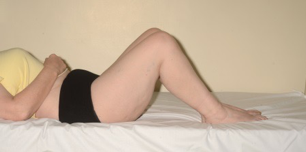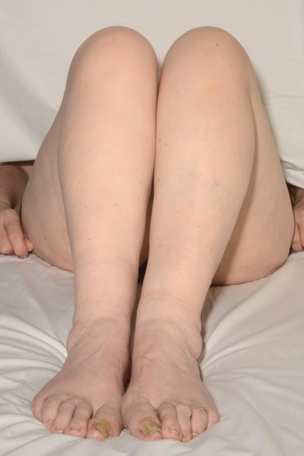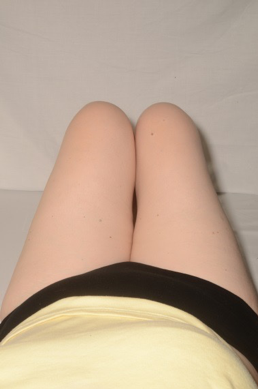Leg lengths
Pre-requisites: Pelvis must be squared to the couch and the limbs placed in identical positions to avoid misreading. If one is unable to place the limb in identical position, the limb length may have to measured in segments (femur & tibia) using bony landmarks.
True limb length is measured from a fixed bony prominence above the hip joint (by convention anterior superior iliac spine) to the ipsilateral medial malleoli using a measuring tape. If there is a limb length discrepancy, Galeazzi's test is performed to identify the short segment.
Galeazzi's test: Hips are flexed at 45 degrees, knees at 90 degrees and back of the heels are placed together (Image 4,5,6).
Bryant’s triangle: If the asymmetry is identified in femoral length, Bryant's triangle is drawn to identify if the shortening is above or below the trochanter.
Apparent limb length is measured from a fixed central point, xiphisternum or umbilicus to medial malleoli and the lengths compared. This is measured to identify any pelvic obliquity - which may be fixed or compensatory.
Functional limb length is measured with patient standing on pre measured blocks. This relies on the patient's perception of the limb length discrepancy and planned correction.
Leg lengths
Pre-requisites: Pelvis must be squared to the couch and the limbs placed in identical positions to avoid misreading. If one is unable to place the limb in identical position, the limb length may have to measured in segments (femur & tibia) using bony landmarks.
True limb length is measured from a fixed bony prominence above the hip joint (by convention anterior superior iliac spine) to the ipsilateral medial malleoli using a measuring tape. If there is a limb length discrepancy, Galeazzi's test is performed to identify the short segment.
Galeazzi's test: Hips are flexed at 45 degrees, knees at 90 degrees and back of the heels are placed together (Image 4,5,6).
Bryant’s triangle: If the asymmetry is identified in femoral length, Bryant's triangle is drawn to identify if the shortening is above or below the trochanter.
Apparent limb length is measured from a fixed central point, xiphisternum or umbilicus to medial malleoli and the lengths compared. This is measured to identify any pelvic obliquity - which may be fixed or compensatory.
Functional limb length is measured with patient standing on pre measured blocks. This relies on the patient's perception of the limb length discrepancy and planned correction.
Pitfalls: The shortening is sub-malleolar if there is a limb length discrepancy, but none detected on true or apparent limb length measurement. This is occasionally seen in patients with previous os calcis fracture or subtalar degeneration. Block test is recommended to quantify the limb length discrepancy.
If unable to place the limbs in identical position, measure different segments; femur and tibia from fixed and identical bony landmarks. Such a situation is encountered in patients with fixed genu valgum or varum



Figures 4-6.Galeazzi's test
Pitfalls: The shortening is sub-malleolar if there is a limb length discrepancy, but none detected on true or apparent limb length measurement. This is occasionally seen in patients with previous os calcis fracture or subtalar degeneration. Block test is recommended to quantify the limb length discrepancy.
If unable to place the limbs in identical position, measure different segments; femur and tibia from fixed and identical bony landmarks. Such a situation is encountered in patients with fixed genu valgum or varum